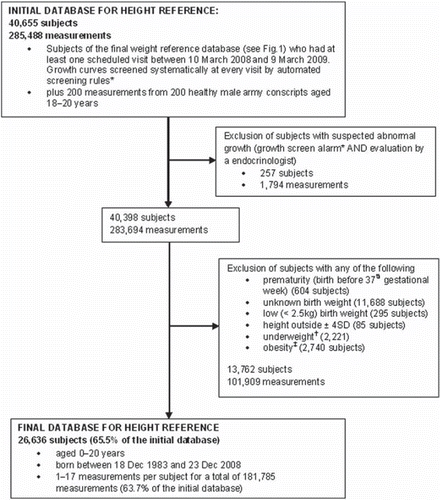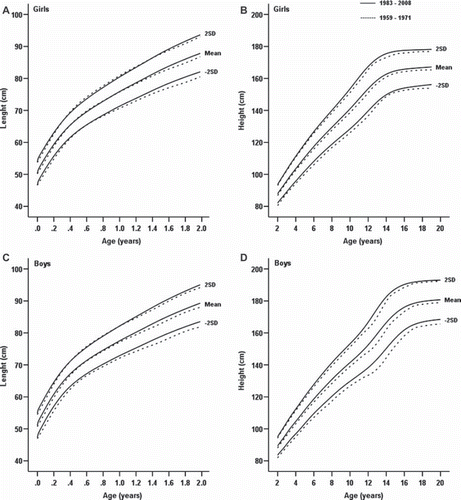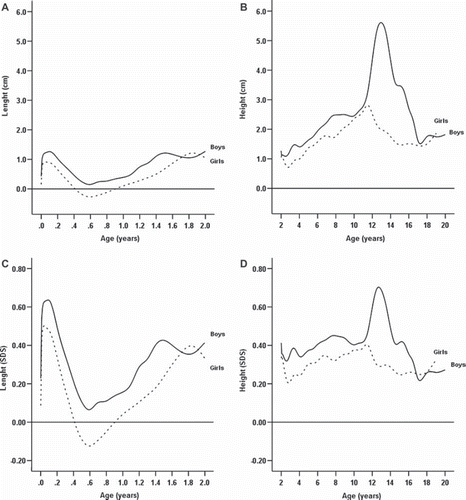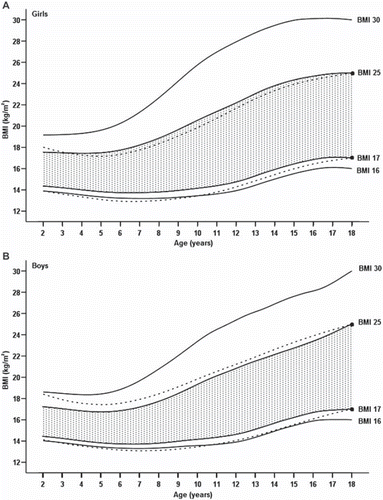Figures & data
Figure 1. Data cleaning procedure for the weight-for-length/height and BMI-for-age reference database.

Figure 2. Data cleaning procedure for the length/height-for-age reference database. *Growth screen: height SDS deviation outside ±2.7 SD from the mean, or outside ±2.3 SD from the target height, or change in height SD in the preceding 1, 3, or 5 years exceeding the allowed age-specific cut-offs; †Underweight: weight-for-height below −15% of the median in height of 50–129 cm, below −20% in height of 130–159 cm, and below −25% in height of 160–180 cm; ‡Obesity: weight-for-height above 20% or 40% of the median weightfor- height in children less than 7 years or 7 years or more, respectively (Citation2,Citation3).

Figure 3. The new Finnish length/height-for-age reference (mean ± 2 SD, solid lines). Curves based on 181,785 measurements from 26,636 full-term healthy subjects born between 1983 and 2008 compared to the current Finnish growth reference based on subjects born between 1959 and 1971 (mean ± 2 SD, dashed lines). A: girls aged 0–2 years; B: girls aged 2–19 years; C: boys aged 0–2 years; and D: boys aged 2–20 years.

Figure 4. Age- and sex-specific features of the secular change in mean length/height in Finland. Comparison between growth reference 1959–1971 population subjects (those born between 1959 and 1971) and reference 1983–2008 population subjects (those born between 1983 and 2008). Curves indicate differences from the reference 1959–1971 population in: A: mean height in cm from birth to age 2 years; B: mean height in cm from age 2 to 20 years; C: mean height in SD units from birth to age 2 years; and D: mean height in SD units from age 2 to 20 years. Dashed line = girls; solid line = boys.

Table I. Number of height measurements in the growth reference 1983–2008 population and percentage of measurements ≤ −2 SD and ≥ +2 SD when compared to the growth reference 1959–1971.
Figure 5. The new Finnish weight-for-length/height percentile (3rd, 10th, 50th, 90th, 97th) curves. Curves based on 428,526 length/height and weight measurements taken from 73,659 healthy subjects in the weight reference 1983–2008 population (those born between 1983 and 2008; solid lines) compared to the median weight-for-length/height curve of the reference 1959–71 population (those born between 1959–1971; dashed line). A: girls 45–90 cm; B: girls 90–180 cm; C: boys 45–90 cm; D: boys 90–190 cm.

Figure 6. The new Finnish BMI-for-age reference percentile curves. The 3rd, 10th, 50th, 90th, and 97th curves are shown for children and adolescents aged 2–18 years. A: girls; B: boys.

Figure 7. Finnish BMI-for-age percentile curves for grade 3 and 2 thinness, overweight, and obesity. Shown are the percentiles passing through BMIs of 16, 17, 25, and 30 kg/m2 at the age of 18 years and the ‘normal BMI area’ between percentiles of grade 2 thinness and overweight (shaded area). Corresponding BMI-for-age percentile curves from multi-ethnic data (dashed lines) indicate grade 2 thinness and overweight (International Obesity Task Force international reference) (Citation30,Citation31). A: girls; B: boys.
